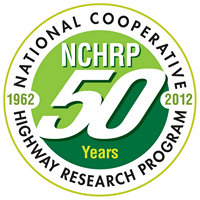
The United States Department of Transportation is one of the executive departments of the U.S. federal government. It is headed by the secretary of transportation, who reports directly to the president of the United States and is a member of the president's Cabinet.
The American Association of State Highway and Transportation Officials (AASHTO) is a standards setting body which publishes specifications, test protocols, and guidelines that are used in highway design and construction throughout the United States. Despite its name, the association represents not only highways but air, rail, water, and public transportation as well.
The Texas A&M Transportation Institute (TTI) in Bryan/College Station, Texas is a transportation research agency in the United States. The institute was created in 1950, primarily in response to the needs of the Texas Highway Department. TTI is a state agency and a member of the Texas A&M University System.

The Federal Highway Administration (FHWA) is a division of the United States Department of Transportation that specializes in highway transportation. The agency's major activities are grouped into two programs, the Federal-aid Highway Program and the Federal Lands Highway Program. Its role had previously been performed by the Office of Road Inquiry, Office of Public Roads and the Bureau of Public Roads.
The National Bridge Inventory (NBI) is a database, compiled by the Federal Highway Administration, with information on all bridges and tunnels in the United States that have roads passing above or below them. That is similar to the grade-crossing identifier number database, compiled by the Federal Railroad Administration, which identifies all railroad crossings. The bridge information includes the design of the bridge and the dimensions of the usable portion. The data is often used to analyze bridges and to judge their condition. The inventory is developed for the purpose of having a unified database for bridges to ensure the safety of the traveling public, as required by the Federal Aid Highway Act of 1968. It includes identification information, bridge types and specifications, operational conditions, bridge data including geometric data and functional description, and inspection data. Any bridge more than 20 ft long used for vehicular traffic is included.
Annual average daily traffic, abbreviated AADT, is a measure used primarily in transportation planning, transportation engineering and retail location selection. Traditionally, it is the total volume of vehicle traffic of a highway or road for a year divided by 365 days. AADT is a simple, but useful, measurement of how busy the road is.

The GEH Statistic is a formula used in traffic engineering, traffic forecasting, and traffic modelling to compare two sets of traffic volumes. The GEH formula gets its name from Geoffrey E. Havers, who invented it in the 1970s while working as a transport planner in London, England. Although its mathematical form is similar to a chi-squared test, is not a true statistical test. Rather, it is an empirical formula that has proven useful for a variety of traffic analysis purposes.
The Transportation Research Board (TRB) is a division of the National Academy of Sciences, Engineering, and Medicine. TRB's mission is to mobilize expertise, experience, and knowledge to anticipate and solve complex transportation-related challenges. For example, committees, researchers, and staff are currently focused on advancing resilient infrastructure, exploring transformational technology, and caring for the public’s health and safety.
The Massachusetts Department of Transportation (MassDOT) oversees roads, public transit, aeronautics, and transportation licensing and registration in the US state of Massachusetts. It was created on November 1, 2009, by the 186th Session of the Massachusetts General Court upon enactment of the 2009 Transportation Reform Act.

The Highway Capacity Manual (HCM) is a publication of the Transportation Research Board (TRB) of the National Academies of Sciences, Engineering, and Medicine in the United States. It contains concepts, guidelines, and computational procedures for computing the capacity and quality of service of various highway facilities, including freeways, highways, arterial roads, roundabouts, signalized and unsignalized intersections, interchanges, rural highways, and the effects of mass transit, pedestrians, and bicycles on the performance of these systems.
Trinity Industries Inc. is an American industrial corporation that owns a variety of businesses which provide products and services to the industrial, energy, transportation and construction sectors.
Pavement management is the process of planning the maintenance and repair of a network of roadways or other paved facilities in order to optimize pavement conditions over the entire network.

Francis Bernard Francois was an American engineer and lawyer who received recognition for his achievements in the field of engineering and policy leadership in regional government, surface transportation infrastructure and research. In 1999, he was elected to the National Academy of Engineering.

Litter in the United States is an environmental issue and littering is often a criminal offense, punishable with a fine as set out by statutes in many places. Litter laws, enforcement efforts, and court prosecutions are used to help curtail littering. All three are part of a "comprehensive response to environmental violators", write Epstein and Hammett, researchers for the United States Department of Justice. Littering and dumping laws, found in all fifty United States, appear to take precedence over municipal ordinances in controlling violations and act as public safety, not aesthetic measures. Similar from state-to-state, these laws define who violators are, the type or "function" of the person committing the action, and what items must be littered or dumped to constitute an illegal act. Municipal ordinances and state statutes require a "human action" in committing illegal littering or dumping, for one to be "held in violation." Most states require law enforcement officers or designated, authorized individuals, to "...witness the illegal act to write a citation." Together, prosecutions and punitive fines are important in fighting illegal littering and dumping.

A digital billboard is a billboard that displays digital images that are changed by a computer every few seconds. Digital billboards are primarily used for advertising, but they can also serve public service purposes. These are positioned on highly visible, heavy traffic locations such as expressways and major roadways.
The Center for Transportation Research (CTR) is a research center affiliated with the Cockrell School of Engineering's Department of Civil, Architectural, and Environmental Engineering at The University of Texas at Austin in Austin, Texas. CTR is a research institution focused on transportation research and education.
Sidra Intersection is a software package used for intersection (junction), interchange and network capacity, level of service and performance analysis, and signalised intersection, interchange and network timing calculations by traffic design, operations and planning professionals.
The flail space model (FSM) is a model of how a car passenger moves in a vehicle that collides with a roadside feature such as a guardrail or a crash cushion. Its principal purpose is to assess the potential risk of harm to the hypothetical occupant as he or she impacts the interior of the passenger compartment and, ultimately, the efficacy of an experimental roadside feature undergoing full-scale vehicle crash testing.

An offset T-intersection is an at-grade road intersection where a conventional four leg intersection is split into two three-leg T-intersections to reduce the number of conflicts and improve traffic flow. Building the offset T-intersections as continuous green T-intersections, there is a single stop on the arterial road, only. A higher volume of through traffic on the cross road, or on unsignalized intersections, a rebuild to a conventional four-leg intersection may be adequate, also when the offset is a few feet only like staggered junctions causing slower traffic for a longer time on the arterial road.

Long-Term Pavement Performance Program, known as LTPP, is a research project supported by Federal Highway Administration (FHWA) to collect and analyze pavement data in the United States and Canada. Currently, the LTPP acquires the largest road performance database.









